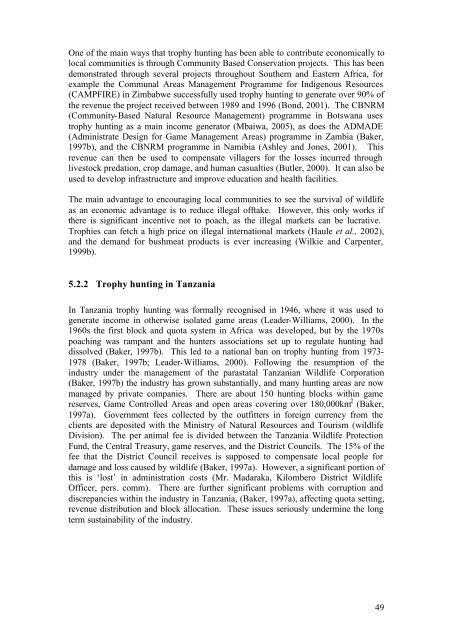Frontier Tanzania Environmental Research - Frontier-publications ...
Frontier Tanzania Environmental Research - Frontier-publications ...
Frontier Tanzania Environmental Research - Frontier-publications ...
Create successful ePaper yourself
Turn your PDF publications into a flip-book with our unique Google optimized e-Paper software.
One of the main ways that trophy hunting has been able to contribute economically tolocal communities is through Community Based Conservation projects. This has beendemonstrated through several projects throughout Southern and Eastern Africa, forexample the Communal Areas Management Programme for Indigenous Resources(CAMPFIRE) in Zimbabwe successfully used trophy hunting to generate over 90% ofthe revenue the project received between 1989 and 1996 (Bond, 2001). The CBNRM(Community-Based Natural Resource Management) programme in Botswana usestrophy hunting as a main income generator (Mbaiwa, 2005), as does the ADMADE(Administrate Design for Game Management Areas) programme in Zambia (Baker,1997b), and the CBNRM programme in Namibia (Ashley and Jones, 2001). Thisrevenue can then be used to compensate villagers for the losses incurred throughlivestock predation, crop damage, and human casualties (Butler, 2000). It can also beused to develop infrastructure and improve education and health facilities.The main advantage to encouraging local communities to see the survival of wildlifeas an economic advantage is to reduce illegal offtake. However, this only works ifthere is significant incentive not to poach, as the illegal markets can be lucrative.Trophies can fetch a high price on illegal international markets (Haule et al., 2002),and the demand for bushmeat products is ever increasing (Wilkie and Carpenter,1999b).5.2.2 Trophy hunting in <strong>Tanzania</strong>In <strong>Tanzania</strong> trophy hunting was formally recognised in 1946, where it was used togenerate income in otherwise isolated game areas (Leader-Williams, 2000). In the1960s the first block and quota system in Africa was developed, but by the 1970spoaching was rampant and the hunters associations set up to regulate hunting haddissolved (Baker, 1997b). This led to a national ban on trophy hunting from 1973-1978 (Baker, 1997b; Leader-Williams, 2000). Following the resumption of theindustry under the management of the parastatal <strong>Tanzania</strong>n Wildlife Corporation(Baker, 1997b) the industry has grown substantially, and many hunting areas are nowmanaged by private companies. There are about 150 hunting blocks within gamereserves, Game Controlled Areas and open areas covering over 180,000km 2 (Baker,1997a). Government fees collected by the outfitters in foreign currency from theclients are deposited with the Ministry of Natural Resources and Tourism (wildlifeDivision). The per animal fee is divided between the <strong>Tanzania</strong> Wildlife ProtectionFund, the Central Treasury, game reserves, and the District Councils. The 15% of thefee that the District Council receives is supposed to compensate local people fordamage and loss caused by wildlife (Baker, 1997a). However, a significant portion ofthis is ‘lost’ in administration costs (Mr. Madaraka, Kilombero District WildlifeOfficer, pers. comm). There are further significant problems with corruption anddiscrepancies within the industry in <strong>Tanzania</strong>, (Baker, 1997a), affecting quota setting,revenue distribution and block allocation. These issues seriously undermine the longterm sustainability of the industry.49
















